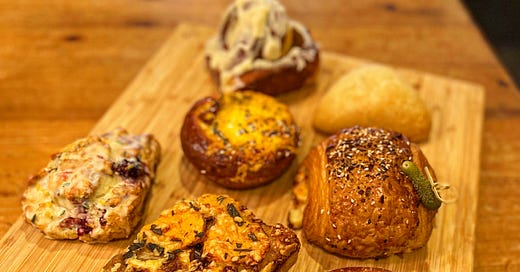If the world were just, the hours of three to five would only seem to appear in the afternoon.
The hours of 3-5 am would still exist of course, but none of us, unless by choice, say for desire of quiet solitude, or because the molly kicked in and the bass drop is far too compelling, should ever witness them.
We don’t live in this world. Our thirst for consumption and business’s desire to quench it, means that like the most dismal of Jimmy Buffet songs, it is always 3 am somewhere and someone is always working a third shift during what we should consider the forbidden or protected hours.
Still, if the money train that defines our lives creates these late-night opportunities, it is still usually someone’s choice, excepting poverty and authoritarian compulsion, to accept those terms.
Bakers and by extension, the bakeries they own, don’t totally have this choice. Sure, humans like pastry after dinner or a cake anytime, but that bakeries’ origins are found in hewing flour and water into life-sustaining bread means that the baker’s wares are demanded on different terms.
The baker toils while most of the world dreams of a daily demanded croissant. That the baker could end their day early might be the return gift, but baking, especially on a small scale generally does not afford that luxury.
A bakery must look like the Wonka factory, bursting with swirls and whirligigs, rivers of chocolate and islands of marshmallow. If you open a bakery serving one kind of cookie, the world will deem you an unimaginative loser.
Variety requires labor. You must know how to ferment, laminate, conjure icing, and temper chocolate. You must be an egg white therapist, intimately aware of the beating your subject can take before it expires. The small-scale baker is an artist, an architect, an engineer, a mathematician and a weather person (humidity dictates so much) as well as a business manager and marketer.
A baker may try to mitigate the labor with technology, say a large-scale mixer, but the best techniques that result in the best flavor require time and patience, and often the delicate touch of a human hand.
Thousands of hours of gluten development or even the clean and jerk action of moving dough balls that possess the heft and compliance of a cadaver from a commercial mixing bowl to a countertop means the forearms of the baker grow sinewy, sore, and sometimes carpal tunneled.
Despite having remarkable computers in our heads accurate at making millions of iterative decisions in milliseconds, we somehow cede our computational might when it comes to judging value and quality of food.
If a baker makes the sacrifices above, and they manage to turn out the best tasting pastry in the world, they will be rewarded with no lack of complaints about how they don’t have a particular pastry, or how the pastry is too expensive (Even though you just spent $6 on a Trenta bucket of Mango Dragonfruit refresher at Starbucks, you are somehow convinced $5 for an artisan-made hand-laminated croissant is robbing from your child’s college fund), or how their hours suck.
Oh yeah, and if you ford all these challenges, you’ve just produced the most perishable product in the world. If you’re lucky, you get a few hours at optimal quality, before experiencing a deterioration which is rarely acceptable after a day. Most famously, the Ritz in London bakes its scones in the afternoon to ensure they’re fresh for tea service.
Small scale bakeries shouldn’t exist. Anyway you slice it, those that do are likely an exercise in brutality. Ironically, slicing played a role in the dwindling of small-scale bakeries. The bread slicing machine was invented in 1928 by Otto Frederic Rohwedder. While it was convenient, sliced bread went stale faster, no doubt convincing patrons that their bakeries were putting out substandard product.
During World War II, production of bread slicers like it was for so many non-essential metal-based products, was halted. Bread machine bans in America freed up tons of alloy steel for the war effort. During the war, baking schools closed. People forgot about the craft or how to teach it.
After the war, faced with a bread shortage and a knowledge deficit, and inspired by the automated example of the bread slicing machine, future bakers moved toward industrialization. They discovered and deployed stabilizers to extend shelf life. Commercial yeasts replaced delicious but unpredictable wild fermentation. Lard and butter were replaced by the Crisco disco, industrial shortenings and eventually neutral or lesser tasting oils which were cheaper but compromised flavor and texture.
The pressures of a commercialized baking culture filtered down. Go to any of the heritage bakeries in Chicago and they are almost all substandard having given way to cheaper low-quality process at least a half-century ago. That some of them have survived over a hundred years is generally a triumph of nostalgia and marketing and not because they make superior product. This also partially explains why the Jewels cake, which IS absurdly delicious, is considered state of the art.
If you have any doubts about how hard it is for a small-scale bakery, consider that there’s actually a secret bakery mafia in Chicago formed for the purposes of finding a way to collectively survive.


